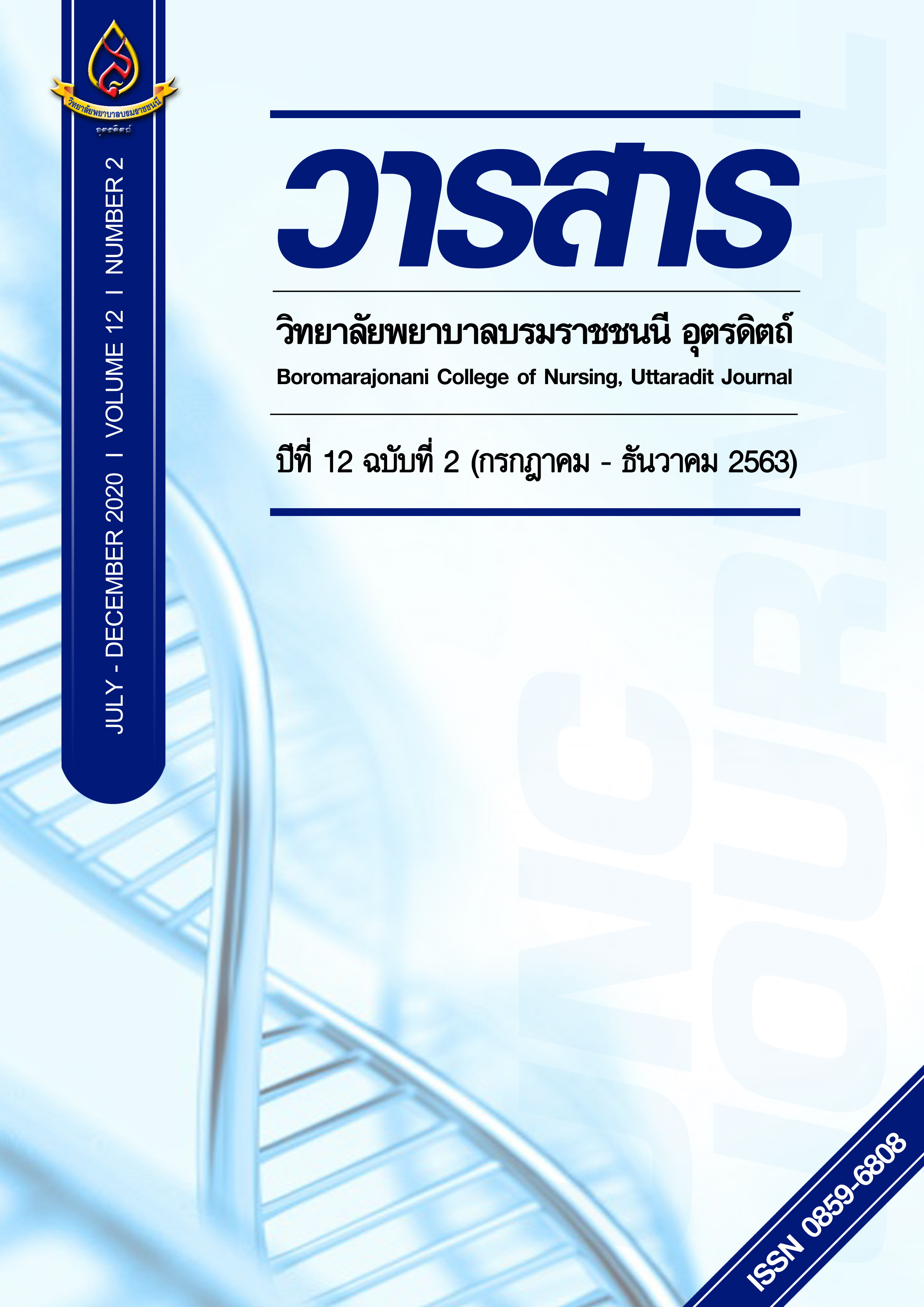บทบาทพยาบาลในการดูแลผู้ป่วยจอประสาทตาลอก
Main Article Content
บทคัดย่อ
โรคจอประสาทตาลอกเป็นปัญหาทางจักษุวิทยา เกิดจากการหลุดลอกของชั้นจอตาด้านในซึ่งเป็นส่วนของเซลล์รับภาพกับเนื้อเยื่อการรับรู้การมองเห็นชั้นนอกของลูกตา เมื่อน้ำจากภายในลูกตาแทรกเข้าไปมาก ๆ จะทำให้เกิดการแยกหลุดของจอรับภาพ ทำให้การมองเห็นลดลงจนกระทั่งทำให้ตาบอด อาการและอาการแสดง ได้แก่ เห็นจุดดำคล้ายหยากไย่ มีแสงไฟแลบในตา เห็นภาพบิดเบี้ยว การรักษาที่นิยมในปัจจุบัน ได้แก่การฉีดแก๊สเข้าไปในน้ำวุ้นตา บทความนี้มีวัตถุประสงค์เพื่อนำเสนอบทบาทพยาบาลในการดูแลผู้ป่วยจอประสาทตาลอก การพยาบาลก่อนผ่าตัดจะช่วยเตรียมความพร้อมผู้ป่วยในการปรับตัวจากการรักษาเนื่องจากหลังผ่าตัดผู้ป่วยต้องอยู่ในท่าก้มหน้าอย่างน้อย16 ชั่วโมงต่อวัน ซึ่งส่งผลกระทบต่อด้านจิตใจและสังคมกับผู้ป่วยอย่างมาก ดังนั้นพยาบาลจึงเป็นผู้มีบทบาทสำคัญในการดูแลผู้ป่วยจอประสาทตาลอกเพื่อป้องกันภาวะแทรกซ้อนที่จะเกิดขึ้น ได้แก่ ต้อกระจก ความดันลูกตาสูง และจอประสาทตาลอกซ้ำต่อไป ส่งผลให้คุณภาพชีวิตของผู้ป่วยดีขึ้น
Article Details
บทความหรือข้อคิดเห็นใดใดที่ปรากฏในวารสารวิจัยการพยาบาลและวิทยาศาสตร์สุขภาพ เป็นวรรณกรรมของผู้เขียน ซึ่งบรรณาธิการหรือสมาคมศิษย์เก่า ไม่จำเป็นต้องเห็นด้วย และบทความที่ได้รับการตีพิมพ์เผยแพร่ถือเป็นลิขสิทธิ์ของวารสารวิจัยการพยาบาลและวิทยาศาสตร์สุขภาพ
เอกสารอ้างอิง
Department of Ophthalmology, Faculty of Medicine, Chulalongkorn University. (2013). Ophthalmic texts science for medical students and general practitioners. Bangkok: Pimpee Company Limited. (in Thai).
Eaton, J., & Johnson, R. (2000). Coaching successfully. United States: Dorling Kiddersley Plublishing.
Encyclopaedia Britannica. (2020). Retinal detachment. Retrieved (2020, February 24) from https://www.britannica.com/science/rhegmatogenous-retinal-detachment. (in Thai).
Eye Health. (2020). Retinal detachment. Retrieved (2020, February 24) from
http://eyehealthbyod.blogspot.com/p/retinal-detachment-50-1.html. (in Thai).
Gupta, D. (2009). Face-down posturing after macular hole surgery: a review. Retina, 24, 430-433.
Janice, A. M., & Carolina, G. H. (2002). Health promotion in nursing. United State of America.
Kraiphibun, P. (2013). Eye disease. Bangkok: Amarin Printing and Publishing. (in Thai).
Krohn, J. (2005). Duration of face-down posturing after macular hole surgery: a comparison between 1 week and 3 days. Acta Ophthalmol Scand, 83, 289-292.
Leksakul, A. (2018). Ophthalmology Ramathibodi. Bangkok: Thammasarn Company. (in Thai).
Noyudom, A. (2018). Care of patients with face-down position after inserting gas in the vitreous cavity. Ramathibodi Nursing Journal, 24(3), 239-248. (in Thai).
Nursing Council. (2015). Scope of advanced nursing practices and competencies of advanced nurses of nursing council. Retrieved (2019, December 24) from http://www.tnc.or.th/diploma/page-3 html. (in Thai).
Patthanathumrongkasem, T., & Akrapipatkul, K. (2011). Treatment outcome of retinal detachment by pneumatic retinopexy at Thammasat University Hospital. Thammasat Ophthalmology Journal, 6(1), 9-16. (in Thai).
Powell, S. K. (1996). Nursing case management: A practical guide to success in managed care. Philadelphia: Lippincott-Raven.
Steel, D. (2014). Retinal detachment. BMJ Clinical Evidance, 2014, 1-32.
Tantisevi, W., Jariyakosol, S., Pruksakorn, W., Aphinyawareesuk, W., & Chantharinthorn, P. (2018). Ophthalmology textbook. Bangkok: Pim Dee. (in Thai).
Tatham, A., & Banerjee, S. (2010). Face-down posturing after macular hole surgery: a meta-analysis. British Journal of Ophthalmology, 94, 626-631.
Xu, Z, Xie, P., Ding, Y, Zheng, X., Yuan, D., & Liu Q. (2016). Face-down or no face-down posturing following macular hole surgery: a meta-analysis. Acta Ophthalmologica, 94(4), 326-333.
Zou, H., Zhang, X., Xu, Xun., & Liu, H. (2008). Quality of life in subjects with rhegmatogenous retinal detachment. Ophthalmic Epidemiology, 15, 212-217.


